The story of the intersection of American women and the nation’s jails is a disturbing one.
Fifty years ago, approximately seventy-five percent of the various county jails around the U.S. contained no women at all.
Today, however, although it is still the case that many more men than women are incarcerated in state and federal lock-ups, in recent decades, the incarceration of women has grown at twice the pace of that of American males.
Most of this growth has been located in county jails across the U.S., a fact that prominently includes the Los Angeles County jail system.
On Tuesday, October 19, the Los Angeles County Board of Supervisors passed a motion that the board hopes will reduce this outsized number of women, and other related vulnerable populations in the county’s lock-ups, and in so doing, help reduce LA County’s jail population overall.
The motion, authored by Supervisor Sheila Kuehl and co-authored by Supervisor Holly Mitchell, is based on the recommended reforms contained in a new report by the county’s Gender Responsive Advisory Committee — or GRAC.
The birth and re-birth of GRAC
In recent years, in response to a body of evidence demonstrating the importance of “gender-responsive, trauma informed care during incarceration,” Los Angeles County acknowledged the need for a “gender responsive” approach to its own women’s jail.
So it was that in February of 2019, the Los Angeles County Board of Supervisors passed a motion titled ‘Building a Gender-Responsive Criminal Justice System,’ in order to help initiate, extend, and maintain efforts to address the needs of justice-involved women.
The motion created an updated Gender Responsive Advisory Committee (GRAC), with representatives from each supervisorial district as well as committee members from the LA District Attorney’s Office, the Office of the Public Defender, and the Department of Health Services, to probe what gender-responsive jails looked like.
(Yes “GRAC” is a less than melodic acronym, but you’ll get used to it. I promise.)
Subsequent to GRAC’s formation, the board of supervisors approved the committee’s request to expand its mission to include finding methods to “uplift” other disproportionately impacted subpopulations in the county’s justice system, by advocating for community-based care over incarceration.
GRAC’s updated mission explicitly named “cis-women” plus “two spirit, lesbian, gay, bisexual, questioning, and transgender, gender non-conforming and/or intersex (2S-LGBQ+TGI)” individuals as part of its target population, and pushed to expand the county’s alternatives to incarceration strategies — such as diversion and community-based prevention programs — to target these groups.
The new GRAC report provides a set of detailed recommendations as to how to keep these populations out of jail to begin with.
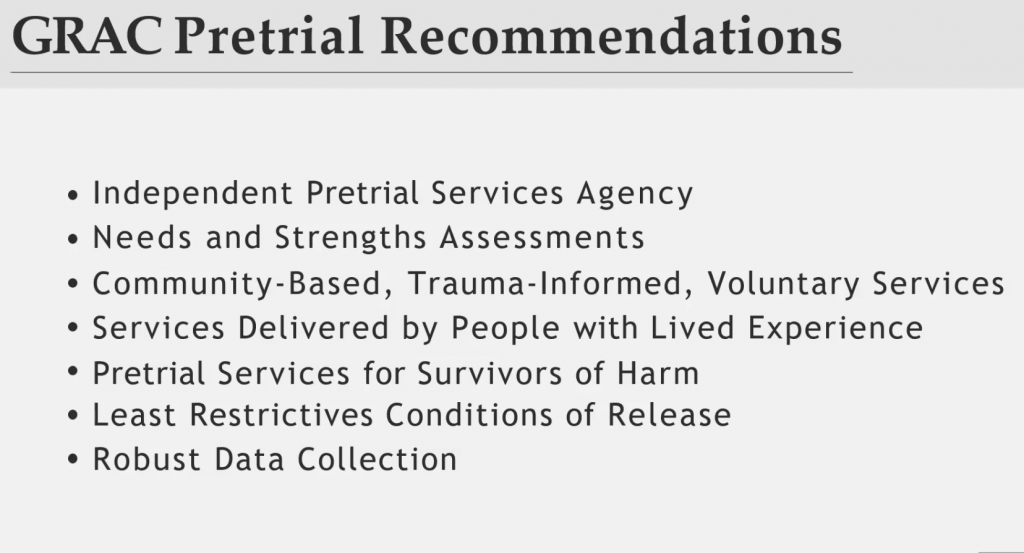
Women and LGBT people in lock-up
Approximately 1,400 women are currently housed in LA County’s women’s jail, the Century Regional Detention Facility (CRDF) located in Lynwood California.
In addition, another approximately 850 gay, bisexual, and transgender people, reside in the jail system’s K6G Unit, raising the total population addressed by the new report to around 2,450 people.
The new GRAC report makes the case that the majority of these particular approximately 2,450 incarcerated people don’t need to be in jail at all.
“Far too many cis women (including people who are pregnant or elderly), as well as two-spirit, lesbian, gay, bisexual, questioning, and transgender, gender non-conforming and/or intersex people are being often needlessly incarcerated when accessible alternatives are available,” writes Eunisses Hernandez, the chair of GRAC, in the new report’s introduction.
Hernandez points to the 2020 Rand Corporation report, about mental health diversion in the LA County jail system, which estimated that 76 percent of those held at the county’s women’s jail have mental health needs, and could be safely diverted.
The $$ issue
The new GRAC report also notes that, between 45% and 60% of the people at CRDF are in jail awaiting trial (the exact percentage varies from day to day), meaning they have not been convicted of the crime of which they are accused, but are locked up because they cannot afford bail.
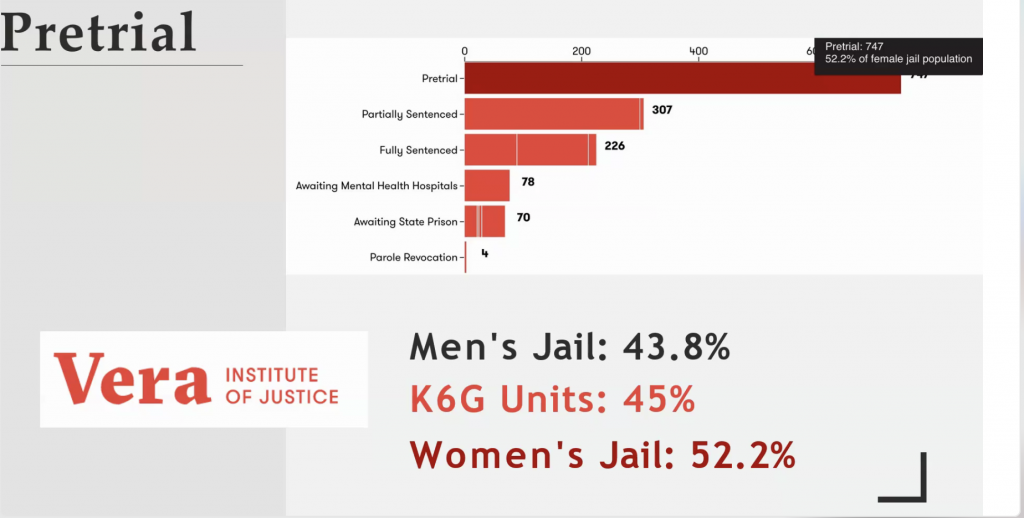
On this issue, the GRAC report cites the California Supreme Court’s landmark Humphrey ruling, which in March of this year directed the state’s courts to consider ability to pay when setting bail.
Implementation of these and other pre-trial reforms, writes GRAC-chair Hernandez, “should dramatically reduce the number of cis women and 2S-LGBQ+TGI people held pretrial at CRDF and in the K6G Unit. ”
The goals and proposed strategies of the new GRAC report interweave with the county’s alphabet soup of other important decarceration initiatives — including the Jail Closure Implementation Team, (which is working, as its name suggests, on the closure of the county’s dungeon-like Men’s Central Jail), the Alternatives to Incarceration Initiative (ACI), the Office of Diversion and Reentry (ODR), and the Jail Population Review Council (JPRC).
On Thursday of this week, experts from the county’s Office of Diversion and Reentry (ODR) along with other justice advocates, delivered an informative and rigorous report to the LA County Sheriff’s Civilian Oversight Commission (COC), which noted that the county’s jail population is, right now, at 14,199 people.
In order to shut down Men’s Central Jail, said the ODR group and other speakers, the county’s jail population must be reduced to 8500 people or below, all of which is doable, if the county sees fit to adequately fund proper diversion and related Alternatives to Incarceration programming.
(More on the funding issue in a WLA story soon to come)
The authors of the new GRAC report hope its recommended strategies will help achieve the needed reduction — a goal that, the report points out, necessitates additional research to illuminate the reasons why women, and LGBT people wind up in the county’s jail system disproportionately.
Retraumatizing traumatized people
Part of the problem, said Supervisor Kuehl when talking about the importance of the new GRAC report, is “our custody system often retraumatizes people who are already victims of poverty and violence.”
A body of painful research agrees.
According to a report by the Vera Institute titled Overlooked: Women and Jails in an Era of Reform,” a staggering 86 percent of women in jail nationally have experienced sexual violence, 77 percent report partner violence, and 60 percent report caregiver violence.
Vera also found that nearly 80 percent of the women in jails are mothers. But, unlike incarcerated men, they are, by and large, single parents, solely responsible for their children.
Those same facts mean that many women who enter jail are already in a precarious financial condition, and so cannot afford bail.
In fact, women are much less likely to be able to afford bail than their male counterparts, so languish in lock-up as a consequence, according to a 2017 Prison Policy Initiative/ACLU report.
Then, as Vera’s research pointed out, “involvement with the justice system can push those women and their families into even deeper financial crises or, worse, provide a direct pathway back to jail for failure to pay off onerous criminal justice debt.”
Yet, another study found that the chances a woman will recidivate after jail are more accurately predicted by her unmet needs, than her prior criminal record.
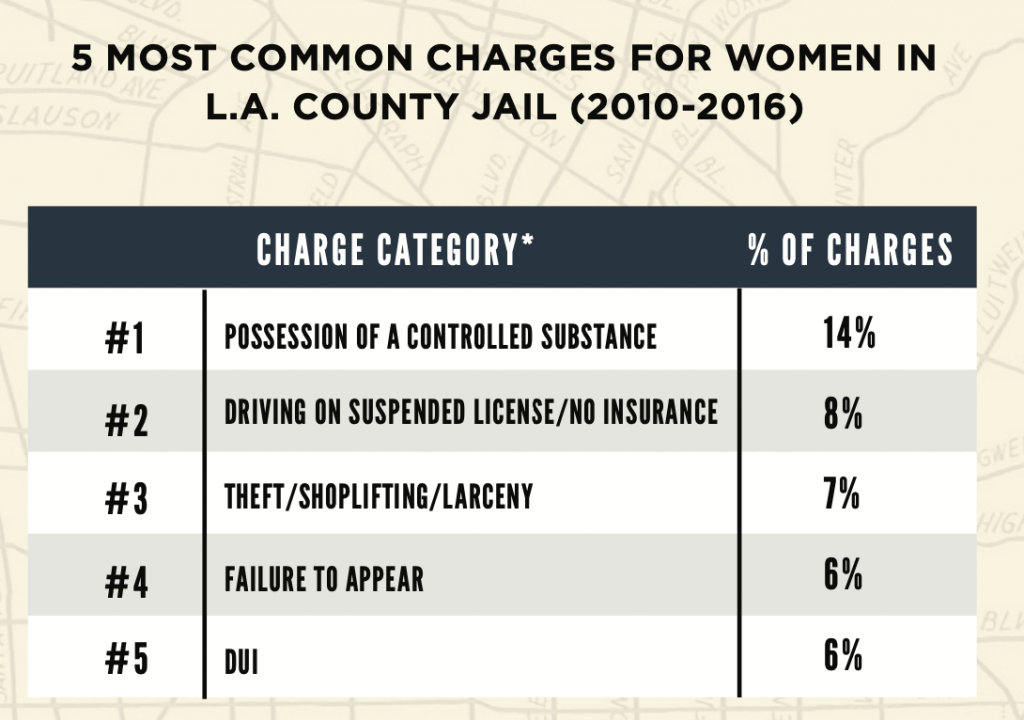
Furthermore, according to a 2019 report by UCLA’s Million Dollar Hoods, of the women who went into the LA County Jail System during the six year period between 2010 and 2016, the five most common charges the women faced were decidedly low level, namely possession of a controlled substance (14 percent), driving on a suspended license or with no insurance (8 percent), theft, shoplifting, or larceny (7 percent), failure to appear (6 percent), and DUI (6 percent).
Nevertheless, in LA County during COVID, incarcerated men were released at a greater rate, than were women. And Black people with mental health needs were released at a lower rater than their white counterparts.
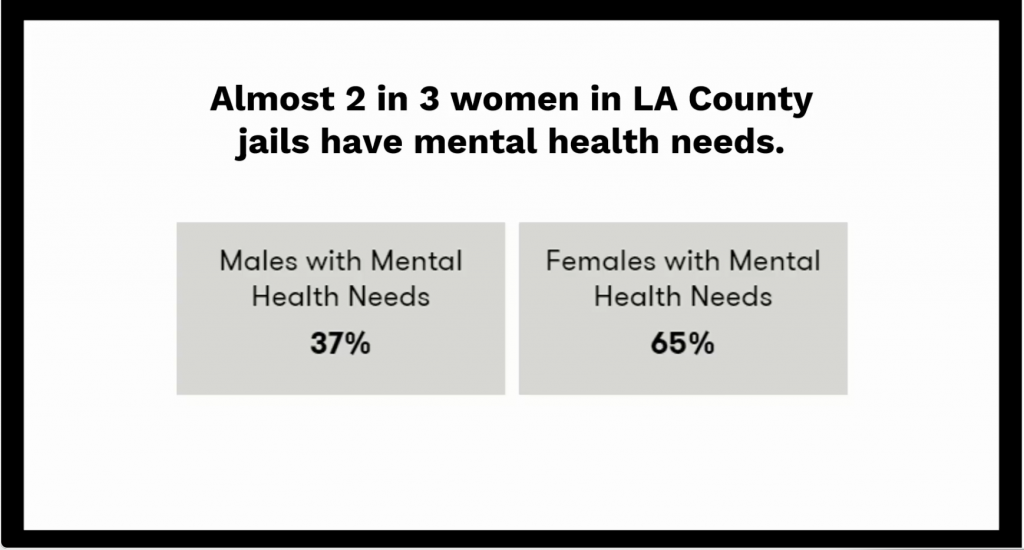
After Tuesday’s board vote, motion co-author Holly Mitchell pointed to the still glaring issue of racial inequities when it comes to the women, transgender people, and related populations in the county’s jails, which the new motion addresses.
“Black women comprise only nine percent of all the women in LA County, yet they make up 33 percent of jail bookings among women,” said Mitchell. “The racial and gender inequities in our jail system are real and must be addressed.
In general, much of the point of the GRAC report and of Tuesday’s motion is a call to better understand the particular group of custody subpopulations the motion addresses, namely, “the cisgender female, lesbian-gay-bisexual and transgender populations,” said Kuehl.
“There are better ways to protect public safety than locking up people who simply need help.”
One would hope.
Photo of at top of Danielle Dupuy of Million Dollar Hoods speaking at a JusticeLA Rally courtesy of the Los Angeles County Gender Responsive Advisory Committee Report

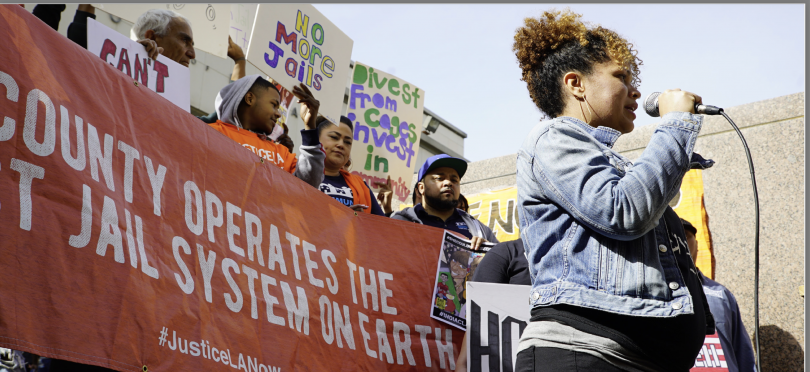
I know it’s off topic but no one seems to want to talk about the obvious. I had a chance to see Mark Ridley-Thomas in action and was always impressed with his tireless efforts to improve the lives of residents in his district. Love him or hate him he was effective. However, the feds indicated him for corruption. Yet the media seems to be minimizing his behavior. It almost seems like an effort to taint the jury pool. The theme, he was just helping his son, does not matter. Given the Feds 99.6% conviction rate, there is substance to this indictment and the media needs to knock the love fest off.
Villanueva’s exploitation of this indictment is disappointing. His behavior of calling everyone corrupt who opposes him is disturbing but validated by this indictment. It is also validated by the medias soft treatment of people with dubious backgrounds.
I read a recent LATimes article regarding Cecil Rhambo. Nothing but a puff piece for Cecil. This man was tied to the hip of Paul Tanaka. His claim to be a reformer is laughable. He was part of the inner circle that lead the Sheriff’s Dept off a cliff. He would not have been in a position to tell Lee Baca, “Don’t fuck with the Feds”, had he not been part of this morally bankrupt senior management team. He may have bowed out regarding obstruction of Justice and saved himself but he was involved in the behavior that brought the FBI to the attention of the Sheriff’s Dept.
It’s time to vote Villanueva out. He has destroyed his credibility and seems incapable of working with anyone. There are good candidates in this race but Cecil is not one of them. It is concerning that so many establishment politicians and the media are supporting his candidacy. He has zero credibility but no one seems to want to talk about his failings. He is not the savior for Villanueva.
@seeking
Who are these good candidates that you speak of ?
Given Cecil’s connection with Paul Tanaka, anybody else would fit the bill. As for Alex. He is a step above Cecil but is unlikely to ever accomplish anything of substance without meaningful collaboration with the BOS. Since he just called them all corrupt, I would hazard a guess his initiatives to impact homelessness, lower crime or anything else are dead.
I noticed an ACTING CAPTAIN and not Alex Villanueva appointed Phillip Marquez at Pico Rivera station. The last time I saw him he was with E.L.A Captain, I.C.I.B and I.A inside E.L.A station in late July 2019.
https://www.facebook.com/PicoRiveraSheriffsStation/videos/icymi-sheriff-alex-villanueva-pico-rivera-station-phillip-marquez-and-pico-river/1317082495312146/